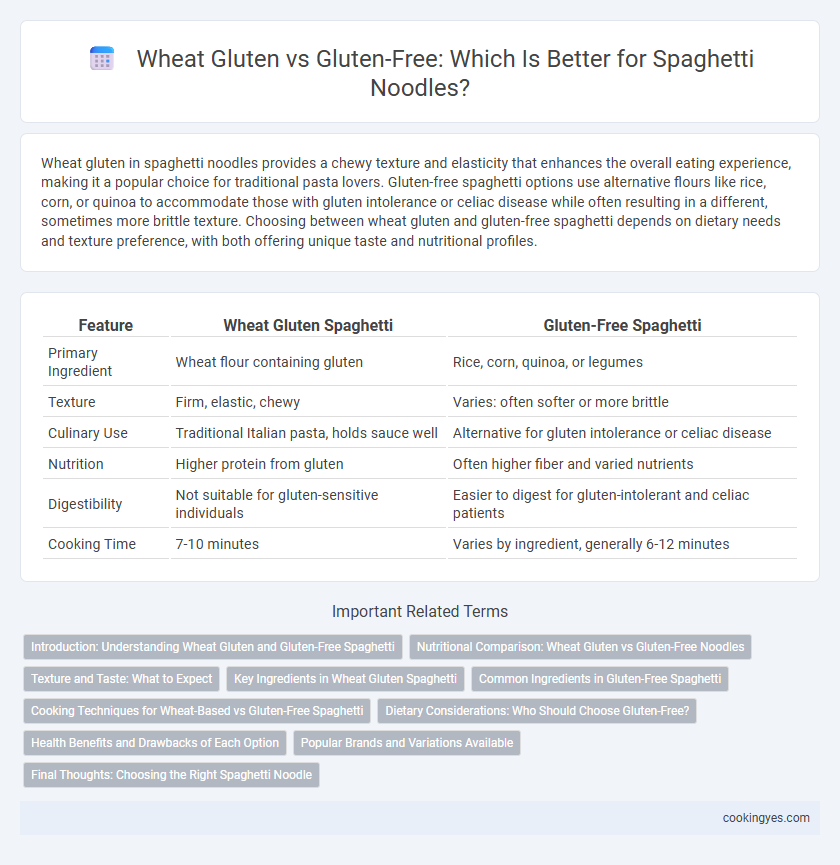Wheat gluten in spaghetti noodles provides a chewy texture and elasticity that enhances the overall eating experience, making it a popular choice for traditional pasta lovers. Gluten-free spaghetti options use alternative flours like rice, corn, or quinoa to accommodate those with gluten intolerance or celiac disease while often resulting in a different, sometimes more brittle texture. Choosing between wheat gluten and gluten-free spaghetti depends on dietary needs and texture preference, with both offering unique taste and nutritional profiles.
Table of Comparison
| Feature | Wheat Gluten Spaghetti | Gluten-Free Spaghetti |
|---|---|---|
| Primary Ingredient | Wheat flour containing gluten | Rice, corn, quinoa, or legumes |
| Texture | Firm, elastic, chewy | Varies: often softer or more brittle |
| Culinary Use | Traditional Italian pasta, holds sauce well | Alternative for gluten intolerance or celiac disease |
| Nutrition | Higher protein from gluten | Often higher fiber and varied nutrients |
| Digestibility | Not suitable for gluten-sensitive individuals | Easier to digest for gluten-intolerant and celiac patients |
| Cooking Time | 7-10 minutes | Varies by ingredient, generally 6-12 minutes |
Introduction: Understanding Wheat Gluten and Gluten-Free Spaghetti
Wheat gluten is a protein complex found in wheat that gives traditional spaghetti noodles their elasticity and chewy texture. Gluten-free spaghetti uses alternative flours such as rice, corn, or quinoa to provide similar firmness without triggering gluten intolerance or celiac disease symptoms. Understanding these differences helps consumers choose noodles based on dietary needs and desired texture.
Nutritional Comparison: Wheat Gluten vs Gluten-Free Noodles
Wheat gluten spaghetti noodles contain higher protein levels, typically around 12-15 grams per 100 grams, providing essential amino acids and contributing to muscle repair and growth. Gluten-free noodles, made from rice, corn, or legume flours, often have lower protein content and may lack certain nutrients such as fiber and iron unless fortified. Consumers seeking balanced nutrition should compare labels, as wheat gluten noodles offer more complete macronutrients, while gluten-free alternatives support dietary restrictions but may require supplementation for equivalent nutrient intake.
Texture and Taste: What to Expect
Wheat gluten in traditional spaghetti noodles provides a firm, chewy texture and a rich, slightly nutty flavor that enhances the overall eating experience. Gluten-free spaghetti often uses rice, corn, or legumes, resulting in a softer, sometimes grainier texture with a milder taste that can lack the elasticity and bite of wheat-based pasta. Expect gluten-free options to vary widely in texture and taste depending on the blend of alternative flours used, often requiring different cooking times to achieve optimal firmness.
Key Ingredients in Wheat Gluten Spaghetti
Wheat gluten spaghetti noodles primarily contain vital proteins such as glutenin and gliadin, which form the elastic network essential for their chewy texture. These noodles rely on durum wheat semolina, rich in gluten, imparting firmness and elasticity that withstands cooking without becoming mushy. In contrast, gluten-free spaghetti substitutes wheat gluten with alternative flours like rice, corn, or quinoa, often requiring binders like xanthan gum to mimic the structural properties of gluten in traditional pasta.
Common Ingredients in Gluten-Free Spaghetti
Common ingredients in gluten-free spaghetti include rice flour, corn flour, quinoa, and tapioca starch, which provide texture and structure without the use of wheat gluten. These alternative flours help maintain firmness and prevent breakage during cooking, ensuring a satisfying bite similar to traditional wheat-based noodles. Many gluten-free spaghetti varieties also incorporate xanthan gum or guar gum to mimic the elasticity that wheat gluten naturally provides.
Cooking Techniques for Wheat-Based vs Gluten-Free Spaghetti
Wheat gluten in spaghetti noodles provides elasticity and firmness, allowing for longer boiling times without losing texture, making it ideal for traditional al dente cooking techniques. Gluten-free spaghetti, often made from rice, corn, or legumes, requires careful timing and frequent stirring to prevent clumping and achieve a balanced softness without becoming mushy. Mastering these differences ensures optimal mouthfeel and structure tailored to each noodle type's unique composition.
Dietary Considerations: Who Should Choose Gluten-Free?
Wheat gluten in spaghetti noodles provides elasticity and a firm texture but is unsuitable for individuals with celiac disease, gluten intolerance, or wheat allergies. Gluten-free spaghetti options, made from rice, corn, or legumes, cater to those requiring strict gluten avoidance while maintaining adequate carbohydrate intake. Choosing gluten-free spaghetti supports digestive health and prevents adverse reactions for sensitive eaters without compromising on pasta enjoyment.
Health Benefits and Drawbacks of Each Option
Spaghetti made from wheat gluten contains a high amount of protein and essential nutrients like iron and B vitamins, which support muscle development and energy metabolism but may trigger adverse reactions in individuals with celiac disease or gluten sensitivity. Gluten-free spaghetti, often crafted from rice, corn, or legumes, offers a suitable alternative for those avoiding gluten and can provide higher fiber content and a range of vitamins, though it sometimes lacks the elasticity and texture found in traditional wheat-based noodles. Choosing between wheat gluten and gluten-free spaghetti impacts digestive health, nutritional intake, and suitability for dietary restrictions, highlighting the importance of personalized dietary decisions.
Popular Brands and Variations Available
Popular spaghetti brands like Barilla and De Cecco typically use wheat gluten, providing traditional texture and elasticity preferred in Italian pasta. Gluten-free options from brands such as Banza and Jovial feature chickpea or brown rice flour, offering alternatives suitable for celiac and gluten-sensitive consumers while maintaining firm bite and taste. These variations cater to diverse dietary needs without compromising the essential qualities of spaghetti noodles.
Final Thoughts: Choosing the Right Spaghetti Noodle
Wheat gluten in spaghetti noodles provides elasticity and a chewy texture, ideal for traditional pasta dishes, while gluten-free options use alternative flours like rice, corn, or quinoa to accommodate dietary restrictions without compromising flavor. Choosing the right spaghetti noodle depends on personal health needs, such as celiac disease or gluten sensitivity, and desired texture preferences in the final dish. Gluten-free spaghetti often requires different cooking techniques to avoid brittleness and ensure a satisfying bite similar to wheat-based pasta.
Wheat gluten vs gluten-free for spaghetti noodles Infographic

 cookingyes.com
cookingyes.com